A valve amplifier or tube amplifier is a type of electronic amplifier that uses vacuum tubes to increase the amplitude or power of a signal. In audio applications, valves continue to be highly desired by most professional users, particularly in recording studios’ equipment and guitar amplifiers. Among stereo enthusiasts, there is a subgroup of audio buffs who advocate the use of tube amplifiers for home listening; they argue that tube amplifiers produce a “warmer” or more “natural” valve sound. Tube sound (or valve sound) is the characteristic sound associated with a vacuum tube-based audio amplifier.
Before the rise of the transistor in the 1950s, all amps used vacuum tubes. Still the audible significance of tube amplification on audio signals is a subject of continuing debate among audio enthusiasts. Audiophiles disagree on the relative merits of tube vs solid state amplification. Tube amplifiers have retained a loyal following amongst some audiophiles and musicians. Some musiciansprefer the distortion characteristics of tubes over transistors for electric guitar, bass, and other instrument amplifiers.
Today tubes are the incandescent light bulb of the audio world: an older, relatively inefficient technology that consumes a good deal of energy to output a modest amount of power. For power amplifiers solid state designs can be manufactured without output transformers and are therefore immune to speaker-dependent impedance mismatches and transforer effects. I have been long the person who has usef transistors for hifi applications and considered they to be better for hifi amplifiers.
Tubes have their place in audio processing where you want to add to the sound the “warm tube distortion” sound (for example in guitar amplifiers). For preamplifer use tubes can work well. To get the idea of tube sound and how tube preamps works, I got this cheap kit for experimenting: AC12V/1A Stereo 2.0 Pre Amplifier Headphone Module Amplifier Buffer Board. It is a preamplifer that is suitable for conntrolling volume of line level audio signals (attenuate or amplify) and maybe add some magic tube sound to audio. Cheap way though of experiencing ‘tube sound’!
Type: FE-6J1-2.0B
Channel type: 2.0/ stereo
Power input: AC12V 1A / 5.5*2.5 plug
Knob function: Power switch / volume control
Size: 76 x 74 x 20mm
Pre-amp tube diameter: 18mm
Everything was packed to a plastic bags.
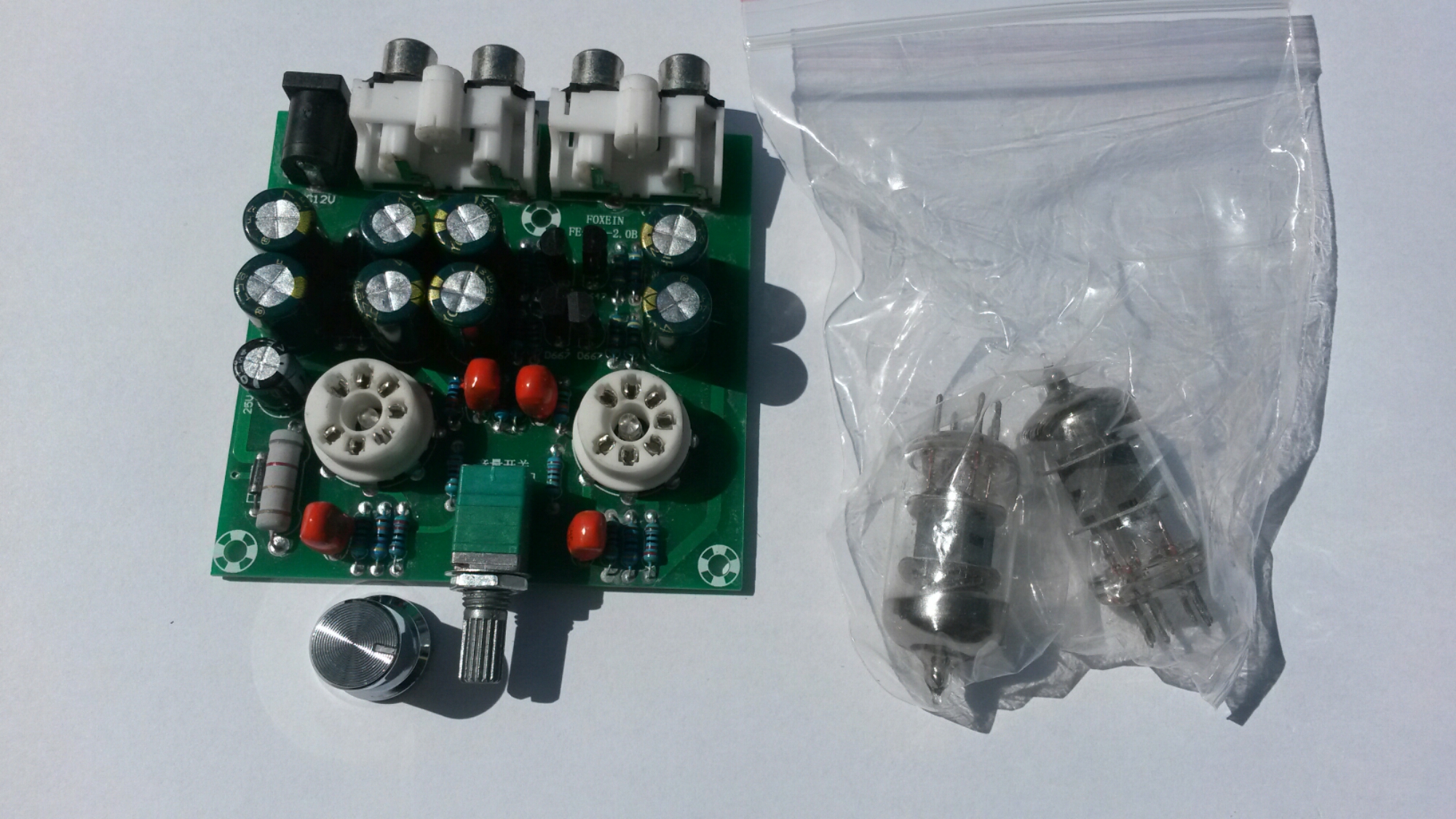
There seem to be some small LEDs in the center of tube sockers. Those are blue LEDs that make the tubes to glow in blue color.
One tube installed.
The volume control in this board is combined volume control and power switch: The knob rotates counterclockwise to reduce the volume, when the volume to the hour, continues to rotate, until the “tick” sound, then power off, lights out.
A look to the connectors…
On the left side: Audio signal input terminals that can be connected to mobile phones, computers, MP3, MP4, and other music player.
On the right side: The output terminal of the audio signal can be connected to an audio signal input terminal of a power amplifier and a power amplifier board. And next to them power input (12V AC 1A).
When I powered the amplifier, it did what it promised. It worked OK as a preamplifier.
Voltage amplification can be controlled from zero to around 6 times (around 15 dB).
The output worked on testing well to over 2Vpp input signal amplitudes at maximum amplitude without noticeable distortion on oscilloscope screen starting to appear.
The signal output impedance is around 3 kilo-ohms. That works well as line level signal preamplifier that drives power amplifier. This circuit is not headphone amplifier that drives headphones (if you thing if that from product name), it would would be pretty non-ideal headphone amplifier for low impedance headphones.
Does what it describes as preamplifier for audio signals. It sounds good, but I can’t find it to be adding any magic “tube sound” to the audio. The circuit adds some slight huming though (at more than about 1/3rd volume).
Note on powering: you need an (not DC) 12V plugpack or transformer. The kit says it needs 12V 1A power supply, so that what I used (I did not measure the actual power this circuit takes).
Ti get better idea how this circuit amplifier works, a circuit diagram would be nice. With some Googling I found that there are several pages that tell about this or very similar tube amplifiers:
https://www.circuitlab.com/circuit/9vnehk/fever-6j1-tube-pre-amp-circuit/
http://www.diyaudio.com/forums/tubes-valves/286349-6j1-tube-buffer-circuit-diagram.html
The best circuit diagram I could found was this at https://www.circuitlab.com/circuit/9vnehk/fever-6j1-tube-pre-amp-circuit/
It seems to be mostly correct (shows only one channel), but has some small details that do not seem to be correct (for example connection of resistor on amplifier output should be connected to ground and not -28V). By the way the circuit diagram can be edited at https://www.circuitlab.com/editor/#?id=9vnehk
As you can see in the circuit diagram the power supply part converts the 12V AC input to +28V and -28V power rails that are used to power the tube. This means that the tube is run at 56V voltage (which is quite low voltage for an audio tube circuit, they typically operate at 100-300V voltage depending on tube type). This 56V voltage is good for safety – it does not hurt too much if you accidentally come in contact with this voltage when you test the board before putting it to case.
The power supply circuit consists of voltage multiplier + rectifier circuit followed with filter capacitors, some transistor circuitry (emitter follower with current limiting, somewhat resembles gyrator circuit) and more filter capacitors.
The tube heaters are directly powered from input 12V AC (two 6.3V heating coils in series can be powered from 12V AC).
Information on the 6J1 tube used can be found at http://www.radiomuseum.org/tubes/tube_6j1.html and http://greatsound168.pixnet.net/blog/post/254453398-%E4%BA%8C%E5%8F%B06j1%E7%B7%A9%E8%A1%9D%E7%B4%9A%E7%9A%84%E5%88%86%E6%9E%90
Another preamp circuit using 6J1 tube at http://www.yunwt.net/1mydiy/qt14.htm
The basic design of this AC12V/1A Stereo 2.0 Pre Amplifier Headphone Module Amplifier Buffer Board seems to be sensible. If I had designd this I would maybe had designed few things slightly differently (for example power supply filtering and maybe tube heating) – that could have maybe reduced the slight mains humming on the output. Anyways as it isC12V/1A Stereo 2.0 Pre Amplifier Headphone Module Amplifier Buffer Board seems to be good quality cheap tube preamplifier.
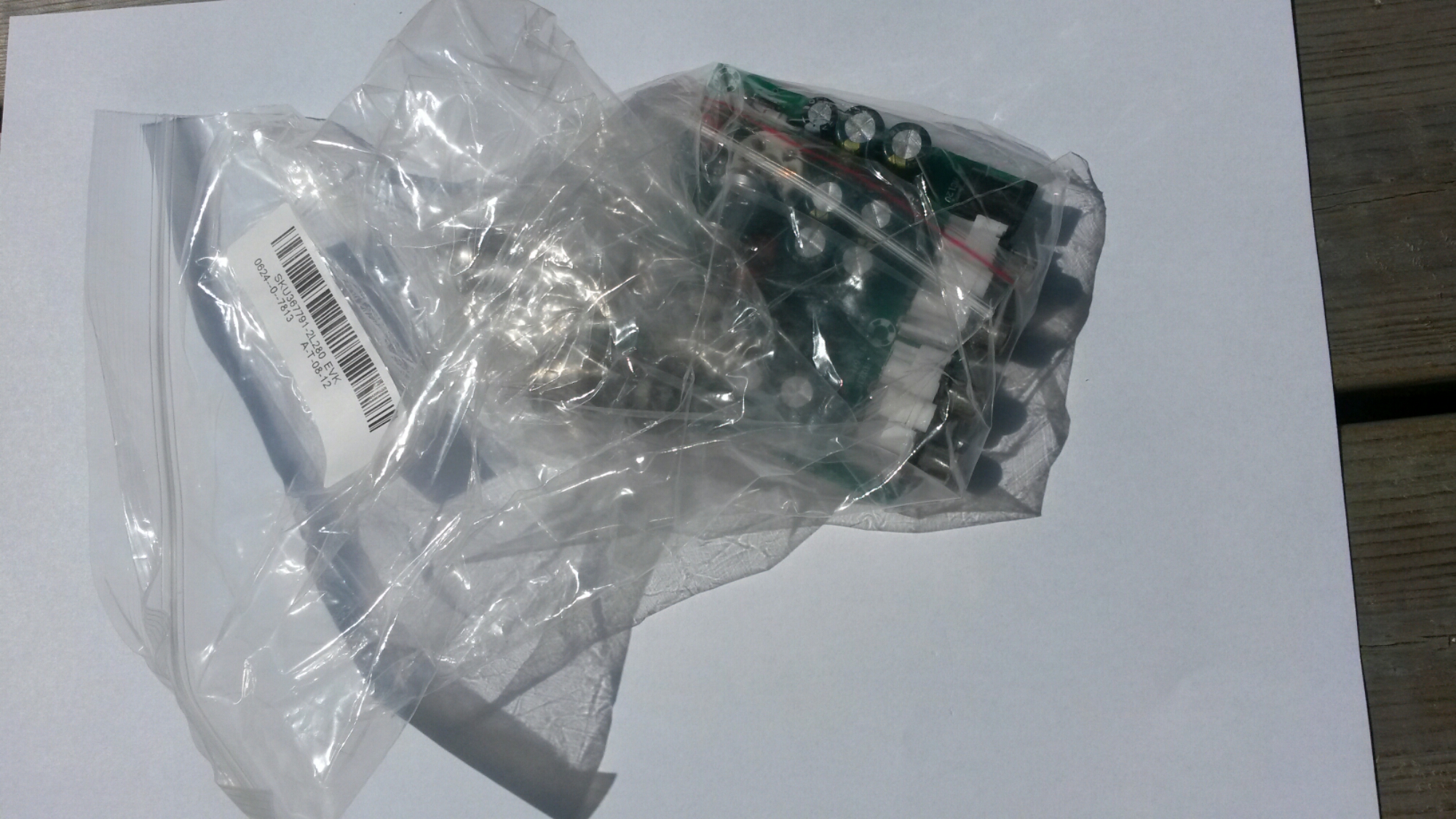
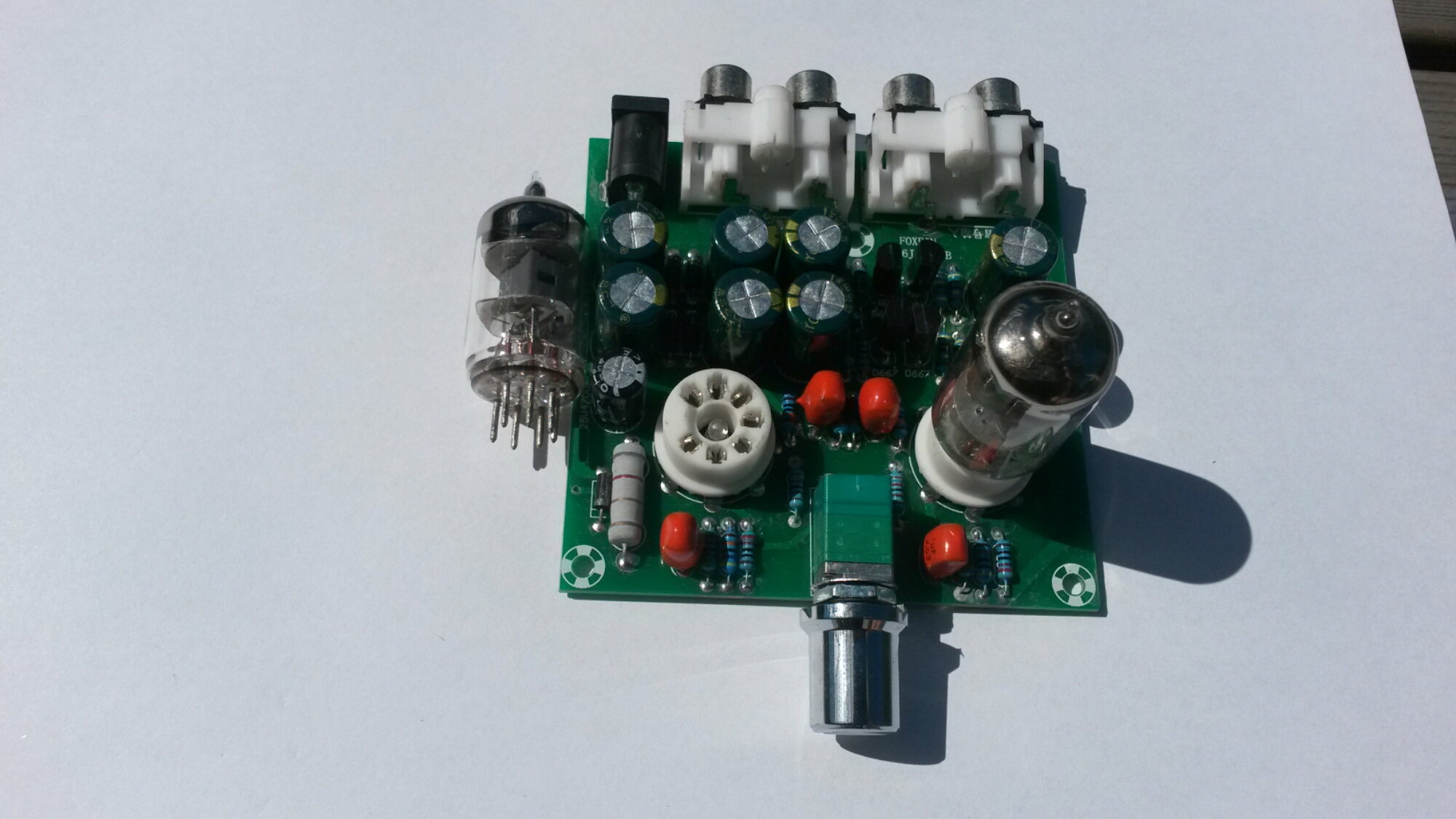
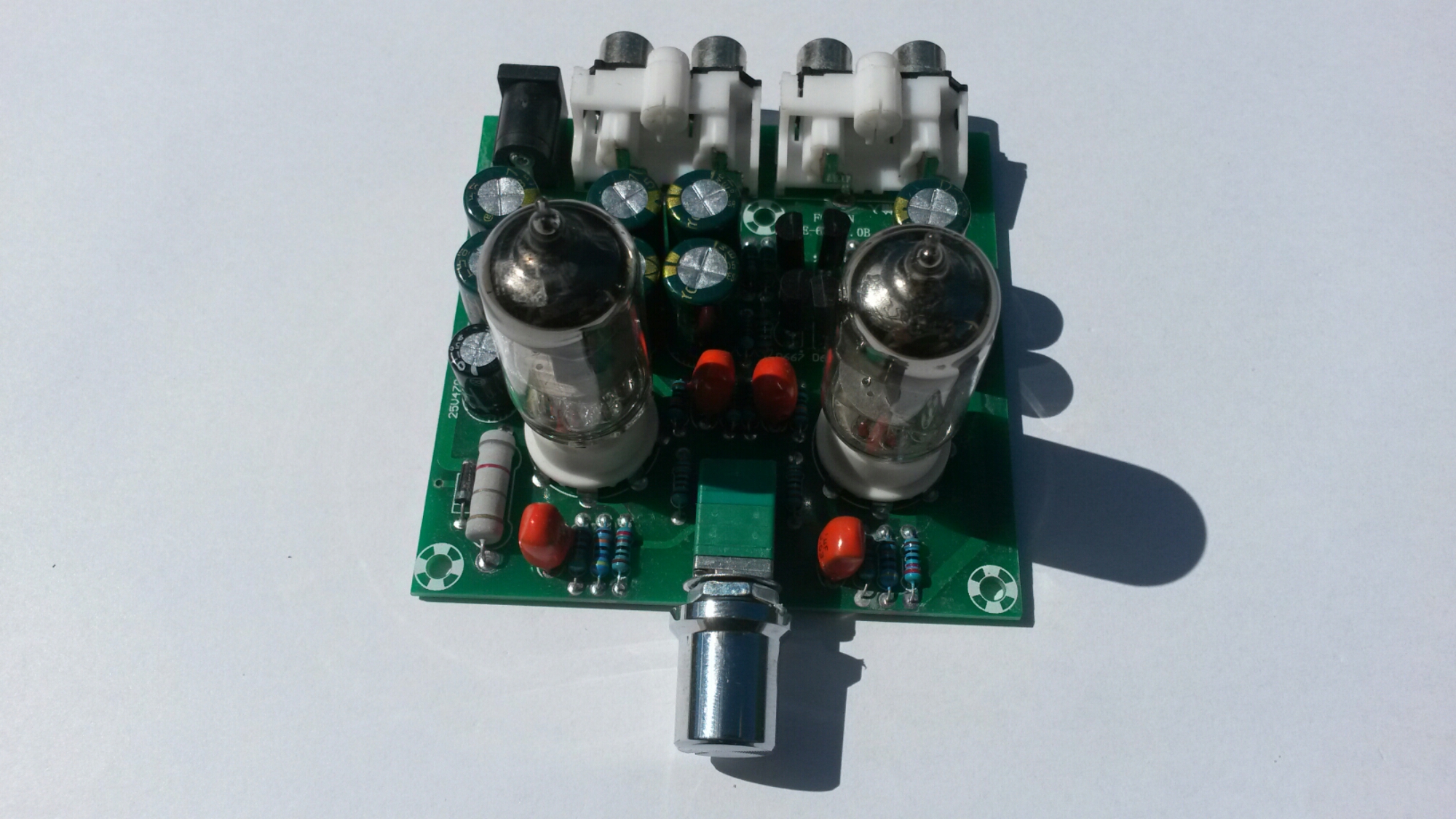
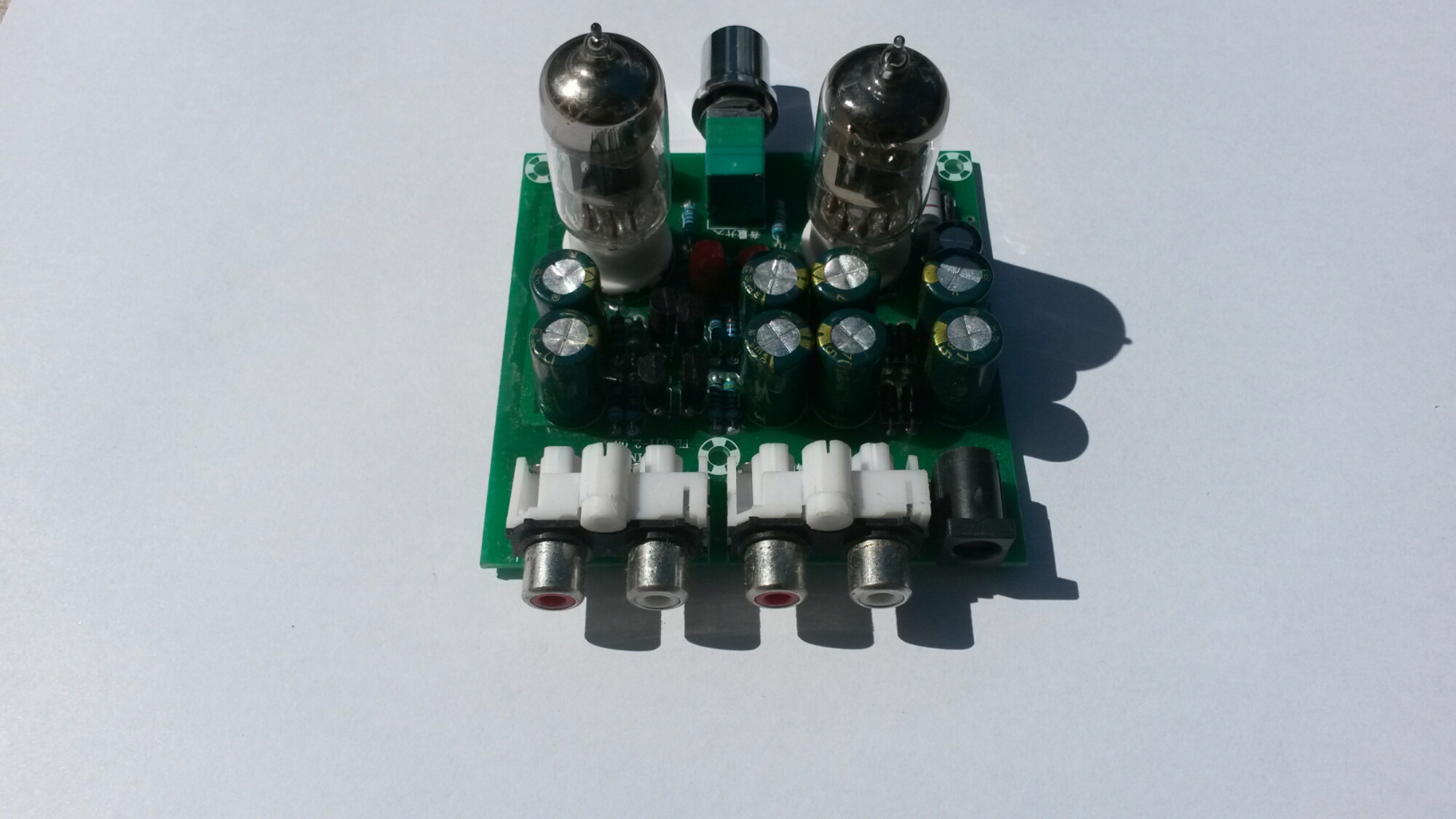
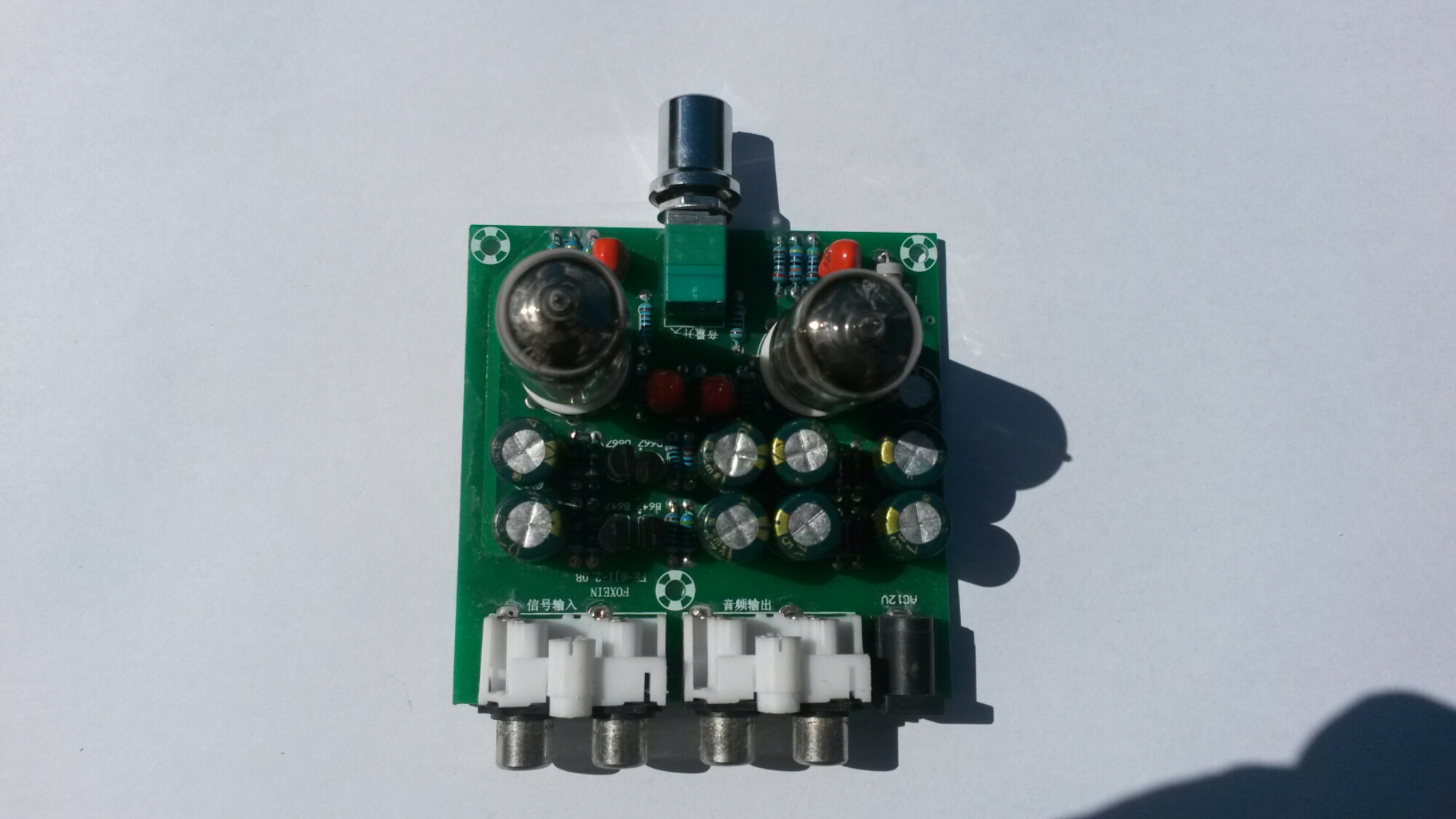
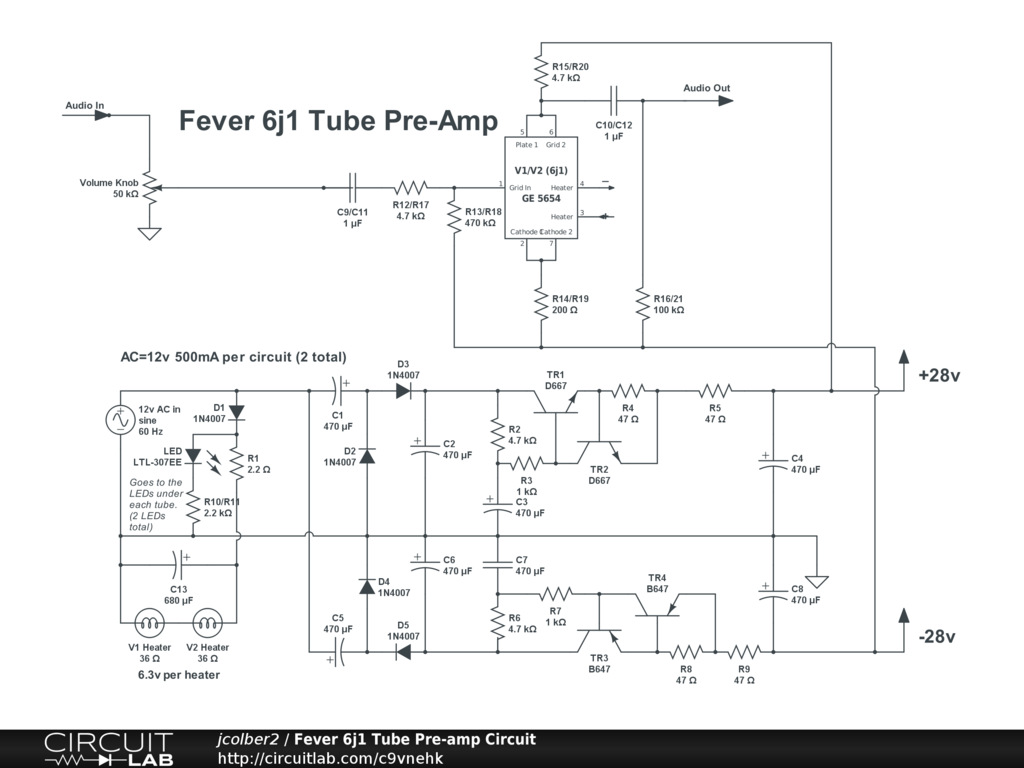
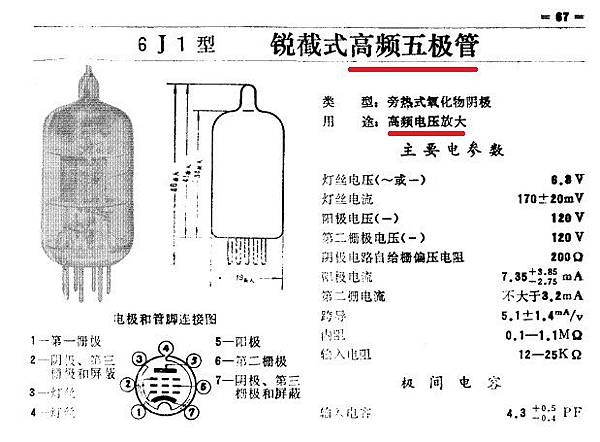
292 Comments
Tomi Engdahl says:
Chinese 6J1 tube buffer – Swapping the LED’s
https://www.youtube.com/watch?v=bXX4YOVUHtI
changing the blue LED’s under the tubes for some shiney new amber LED’s
Tomi Engdahl says:
Tube 6J1 data sheet
http://tdsl.duncanamps.com/show.php?des=6J1
https://frank.pocnet.net/sheets/095/6/6J1.pdf
Tomi Engdahl says:
Vacuum Tube Amplifier
ECE 445 Design Document
https://courses.engr.illinois.edu/ece445/getfile.asp?id=12552
Tomi Engdahl says:
Custom Tube Consoles
http://www.customtubeconsoles.com/
Tomi Engdahl says:
Vacuum tubes preamplifier soldering and testing.
https://m.youtube.com/watch?v=0I6GOZkchI8
Tomi Engdahl says:
Tubes: Luckily, They’re Still Around
https://www.electronicdesign.com/communiqu/article/21133402/tubes-luckily-theyre-still-around?utm_source=EG+ED+Analog+%26+Power+Source&utm_medium=email&utm_campaign=CPS200604078&o_eid=7211D2691390C9R&rdx.ident%5Bpull%5D=omeda%7C7211D2691390C9R&oly_enc_id=7211D2691390C9R
So, unicorns are gone for good. But not vacuum tubes. It doesn’t seem that tubes will ever disappear completely—they’re still with us and that’s a good thing. I was reminded of that several times over the past weeks.
For example, I was scanning the ads for a high-power ham-radio amplifier. Most of the popular transceivers top out at about 100 W. For good long-distance (DX) communications around the world on the high frequency bands (3 to 30 MHz), more power is desired. A number of companies make accessory power amps to boost power level to the FCC legal limit of 1500 W.
Both transistor and tube models are available to choose from. The solid-state amps use multiple RF MOSFETs to get to levels of 500 to 1000 W. These are very expensive. To get to that same power level, you can buy an amp with one or two tubes at about half the price of the transistor model. The old but apparently still good 811 tubes are widely used. And air-cooled tubes like Eimac CX800A7 and Svetlana 4CX800A are other favorites. The tube amps are quite a bargain.
Sounding Off: Tube or Solid-State Amp?
My other reminder about tubes was in looking for a new guitar amplifier. These come in all shapes and sizes with power levels of 10 to 20 W up to over 100 W. Both tube and solid-state amps are available. Some of the smallest amps use class D switching amps that give you lots of power in a very small package.
As it turns out, there are more vacuum-tube guitar amps than solid-state amps. Most guitar players, except maybe for a few heavy metal types, prefer the sound of a tube amp. The tube sound is said to be warmer, fat-toned, and organic. It’s a personal thing as the sound difference is subtle. You have to hear the two versions to feel it or “get it.” That difference is real. The tube amps just sound better and louder with nuances.
The most popular tube amps use a pair of EL84 power tubes. These are also known as 6BQ5s. Virtually all are made in the U.K., Russia, and Europe. Like most tubes, they must be replaced every now and then. You can still get replacements for $10 to $20 each.
Guitar amps also use tubes in their preamps. Most common among them are the popular dual triodes 12AX7 and 12AU7. Some use ECC83s.
There are also hybrid amps with tube preamps and solid-state power amps. You can even buy a solid-state power amp with a DSP feature that makes the amplifier sound like a tube version. Called modeling amps, these programmable units make it possible to create your own unique sound. You can also add effects like delay, tremolo, distortion, reverb, and others.
The inexpensive solid-state amps at the 10- to 20-W level sell for $100 to $200. A 100-W tube amp can sell for several thousand dollars depending on the accessories.
Vacuum tubes are still a big deal in the guitar world. And much of the appeal of tube amps to guitarists exists in those high-end audio enthusiasts. You can still buy big-buck high-fidelity amps with tubes, and many fans swear by them.
Tomi Engdahl says:
https://hackaday.com/2020/06/20/chasing-a-long-obsolete-tube/
Tomi Engdahl says:
https://www.audiovideo.fi/opas/putkivahvistinrakennusohje-revenge-pl36-se/
Tomi Engdahl says:
Audiophile Justin Scott created crafted a custom tube preamp featuring a (remote-controllable) motorized volume knob and Nixie display.
Vacuum Tube Preamplifier with Nixie Display
https://hackaday.io/project/173231-vacuum-tube-preamplifier-with-nixie-display
A custom vacuum tube pre-amplifier featuring remote control and a nixie tube volume level display
Tomi Engdahl says:
Just Who Makes Tubes These Days?
https://hackaday.com/2020/08/06/just-who-makes-tubes-these-days/
Alive And Kicking In The 21st Century
As our consumer electronics have become ever more digital in their make-up, interest has blossomed in analogue devices, or at least devices with a visibly analogue component. In particular the world of audio has begun to chase the elusive “tube sound”, whether it be in the context of intentionally overdriven amplifiers for the guitarist, or closer to perfect ones for the audiophile.
High-end hi-fi shops are full of tube-based devices, and a plethora of tube amplifier kits are available for the electronics enthusiast. Tubes can be bought under a bewildering array of brands often at eye-watering prices, something of a surprise for a technology which might be presumed to have disappeared over four decades ago. This does raise an interesting question though, with such a large number of tube brands on the market, where are they all made, and how have their manufacturers survived for so long? The answer is relatively straightforward, yet in other aspects a story of labyrinthine complexity.
While consumer vacuum tubes might have disappeared from mundane electronics decades ago, it’s first worth pointing out that many of the old names in the vacuum tube business didn’t stop manufacturing vacuum tubes, they simply stopped making the tubes you might be familiar with.
High power RF amplifiers for UHF and higher frequencies for example still use vacuum tubes, be they specialised planar tubes or slightly more exotic fare such as klystrons. Similarly there are specialised RF applications that still use travelling wave tubes, and very high power industrial equipment that uses vacuum and gas-filled tubes for control or rectification.
But who is making the “normal” tubes — the smaller glass-envelope tubes, small triodes and pentodes such as you’d find in that guitar amplifier? We recognize some names from times past such as Telefunken or Mullard, others are modern brands such as JJ or Fender’s Groove Tubes brand, and others are clearly Russian or Chinese names such as Svetlana, SovTek, “Winged C“, or Shuguang. Clearly there are not as many tube factories left in the world as there are logos stamped on the glass of imported tubes, so what on earth is going on?
The answer is that the consumer tube business in 2020 is no longer a commodity component market producing the lifeblood of a million televisions and radios, instead it’s a boutique operation serving a niche market.
A current-manufacture Mullard-branded ECC83 (12AX7) general purpose small signal double triode for example costs $43.20 (£35.09) in 2020, while browsing a 1957 copy of Wireless World we find the same part number advertised for 8 shillings and thruppence, which is £0.41 ($0.51) in post-decimalisation British money. Using the Bank of England’s inflation calculator that comes out at about £9.96 ($12.27) today, so the modern re-issue is more than three times as expensive as was the genuine article in its heyday. This is evidently a business with a significant mark-up, and the world’s remaining tube factories are cashing in.
Investigating further, we find that tube manufacture of this type appears to be entirely absent from the Americas and Western Europe. It survived the decline of the 1970s in Russia, China, and the formerly Communist states of eastern Europe, and as Soviet communism fell and the Chinese economy grew in the 1990s it emerged from the shadows to supply the audio market.
Is It Really Worth It Though?
As someone who has been a vacuum technology enthusiast for four decades now it makes me happy to find that tubes are still in production and their industry appears healthy for now. But my tour through the world of 21st century tube manufacture leaves me slightly disappointed that so much of their marketing is still clouded by mythology.
As someone who was building tube amplifiers with Yugoslavian TV tubes back when it was extremely unfashionable, I understand the allure of that elusive “tube sound”, but experience has taught me that it’s not as great a thing as its proponents would have you believe. Even the distortion characteristics sought by musicians can more easily be created through DSP in 2020, so I can’t help the feeling that people are being led astray as I see essentially the same tube being sold at a range of different prices based solely on its brand. Enjoy working with tubes, and enjoy listening to a tube amplifier. But don’t make the mistake of falling into the trap of falling for the hype, and never lose sight of the engineering.
Tomi Engdahl says:
That Elusive Valve Amp Sound, For Not A Lot! (There Has To Be A Catch)
https://hackaday.com/2020/09/01/that-elusive-valve-amp-sound-for-not-a-lot-there-has-to-be-a-catch/
Tomi Engdahl says:
High Voltage MOSFET Follower
https://sound-au.com/articles/followers.html#s9
Tomi Engdahl says:
https://hackaday.com/2020/09/10/reverse-engineering-a-module-from-a-vacuum-tube-computer/
Tomi Engdahl says:
https://hackaday.com/2020/08/06/just-who-makes-tubes-these-days/
Tomi Engdahl says:
How It’s Made – McIntosh Tube Amp
https://www.youtube.com/watch?v=2HgS6gvokEI
some of the steps in building a McIntosh tube amp
Tomi Engdahl says:
https://spectrum.ieee.org/tech-history/space-age/the-11-greatest-vacuum-tubes-youve-never-heard-of
Tomi Engdahl says:
Some people like to listen the “warm” un-linearity of Vacuum Tube Amplifier
Tomi Engdahl says:
Vacuum tubes in audio amplifiers do deteriorate sound quality differently than transistors do. Typically tube amplifiers deteriorate sound more in measurable parameters more than good transistor amplifiers but tubes do deterioration in a way that many hifi equipment buyers find more pleasing to their ears.
Tomi Engdahl says:
BenjaminJr Viloria here are two sources on tube vs transistor
http://www.theaudioarchive.com/TAA_Resources_Tubes_versus_Solid_State.htm
https://www.cnet.com/news/what-sounds-better-tube-or-solid-state-electronics/
Tomi Engdahl says:
There is a science called “psycho acoustic” that deals with the perception of a sound. If you do acoustic measure transistor are better for linearity, if you do psycho acoustic measure you find that tube sound is more appreciated because “warm”.
Tomi Engdahl says:
https://www.kenrockwell.com/audio/why-tubes-sound-better.htm#:~:text=Just%20like%20our%20ears%2C%20musical,to%20have%20it%20sound%20best
Tomi Engdahl says:
What sounds better, tube or solid-state electronics?
Solid-state technology all but obliterated the vacuum tube market in the early 1960s. So why are tubes still popular with audiophiles and musicians?
https://www.cnet.com/news/what-sounds-better-tube-or-solid-state-electronics/
Tomi Engdahl says:
http://www.theaudioarchive.com/TAA_Resources_Tubes_versus_Solid_State.htm
Tomi Engdahl says:
Vacuum tube amplifier or preamplifier?
https://www.youtube.com/watch?v=j2vPU4ShL-c
If you could only upgrade one product in the chain to a vacuum tube for added warmth, would it be the preamp or power amp and why?
I know he’s gonna say tube preamp, solid state power amp.
Tube power amps for guitar are common but I think it is not so good idea for hifi!
Tomi Engdahl says:
Building a Tube Amp! Does it produce better audio quality though? EB#47
https://www.youtube.com/watch?v=RoSIzgvEGtA
will show you how such vacuum tubes works and how to create a simple class A amplifier with them. At the end I will then show you why some people still like using them even 100 years after their invention, even though they offer lots of disadvantages.
Tomi Engdahl says:
Single-ended amplifiers are ear pleasing. As I put it back in post 363, “A well-executed single-ended amplifier sounds as smooth as polished marble and as strong as the muscled fellow who can do one-arm pull ups.”
https://tubecad.com/2018/01/blog0408.htm
Tomi Engdahl says:
A Very Modern Tube Headphone Amplifier
https://hackaday.com/2021/02/27/a-very-modern-tube-headphone-amplifier/
Once a discarded relic, over the years the humble vacuum tube has been rehabilitated in the arena of specialist audio. There are plenty of tube amplifiers now being manufactured, with a popular choice being headphone amplifiers that use a tube as a gain stage followed by an op-amp as a buffer with a low impedance output. This forms the basis of [Ratti3]’s amplifier, but with the added interest of a battery supply and a Bluetooth connection.
The tube circuit is a very conventional anode follower using an EF95 pentode. This provides plenty of gain and of course that “valve sound” beloved of audio enthusiasts, but suffers from an output impedance too high to drive a set of headphones. An NE5532 steps in for the op-amp buffer role, making for a very simple circuit. Power comes from a set of four 18650 Lithium-Ion cells with associated charger and balance boards, while a little switching boost converter provides the 100 volt HT for the tubes.
Battery Operated Hybrid EF95 Valve Amplifier
https://hackaday.io/project/177751-battery-operated-hybrid-ef95-valve-amplifier
A custom build of a valve amplifier using two 6AK5/EF95 valves, 4S battery pack with protection, charging module and battery level indicator
Tomi Engdahl says:
The whole “tube is better” argument is about as silly as the turntable argument.
It is totally dependent on the design and budget and personal preferences.
Some people like modulation on vinyl and second harmonic distortion with tubes.
Theres even cable manufacturers who’s cables act as RF antennas to create a pleasing dithering effect to music to inject warmth.
Tomi Engdahl says:
There’s a reason vacuum tubes haven’t been widely used since the 1970s
There is also a reason why many people are prepared to spend big on valve amps. They may not be as accurate as some solid state can be. But they can be capable of making the listening experience more satisfying to some people.
Tomi Engdahl says:
First it is a myth that transistors have less distortion then tubes. Used in identical circuits the tube will measure better.
And yet SS amp tends to measure better than a tube amp. Why? Transistors are cheap and you can use several to create a much more complicated circuit with plenty of negative feedback. Also tubes tend to use transformers to couple the impedance to the speaker properly. Audio transformers are a big source of distortion. Even bigger than tubes. Solid state design skips the transformer completely.
Tomi Engdahl says:
“There is no way around it: linear [triode] vacuum tubes have lower overall distortion than bipolar transistors or FETs, and the distortion products are primarily lower-order…the clipping characteristic of tubes is actually not much softer than transistors, but feedback tends to ‘square-up’ the clipping”
https://spectrum.ieee.org/consumer-electronics/audiovideo/the-cool-sound-of-tubes
Tomi Engdahl says:
I mean I don’t know about Superior however it depends on the application for audio it depends if you’re looking for certain distortions and harmonics most people call Warmness. There’s also reliability issues. In my opinion the reason we are still not using tubes in everything today gives you your answer. But like I said it all depends on the application.
Tomi Engdahl says:
There is an old polish saying: some prefer the daughters some prefer the mothers…
They both emit a different set of harmonic characteristics. Neither are “wrong.”
Tubes are voltage amplifiers while transistors (bjt) are current amplifiers. They both have their utilities. Tubes have high impedance inputs (control grid) and need high voltage to operate. Field effect transistors (Fet) are also voltage amplifiers with high impedance input (gate) and perform much like tube but at a lower voltage. For power without output transformer, BJT and Mosfet is the way to go.
Solid State devices are always better in audio power amps because a transformer is limited in its frequency range but is an essential in tube amps !
Transistors are less expensive, smaller , lighter, more reliable, capable of higher power, and offer extremely good sound quality. All recordings made since the 1960′s have been processed by multiple transistors in the signal chain before they ever arrive to your ears. If you want to waste electricity, maybe add heat to your home, or just enjoy looking at tubes glow, then get equipment with tubes in them. For all practical use, the transistor is the better choice.
Tomi Engdahl says:
All depends your preference and acceptance only. Nothing right or wrong, only thing is like or dislike.
Tomi Engdahl says:
https://www.diyaudio.com/forums/class-d/69538-tubes-class.html
Tomi Engdahl says:
The major benefit of the tubes is better linearity ( many other properties is worse),
Tomi Engdahl says:
https://hackaday.com/2021/03/07/a-tiny-tube-amp-for-not-a-lot/
Tomi Engdahl says:
Tube amp comments:
https://www.facebook.com/groups/DIYAudio/permalink/4012278565504626/
It is designed to run at lower anode voltage to put the curves into the slightly non-linear range. That gives it about 1 to <1.5% 2nd order distortion and thus the "tube" sound. Make it operate close to the tube's spec voltages and you might as well just use a solid state buffer.
Tomi Engdahl says:
https://attitube.com/tube-projects/tube-line-amplifier/nggallery/image/morpheus_line_amplifier_diagram_01/
Tomi Engdahl says:
https://www.diyaudio.com/forums/tubes-valves/110600-tube-rise-time-slew-rate.html
Tomi Engdahl says:
https://www.gearslutz.com/board/geekzone/8286-slew-rate-amp-transformer-coloration.html
Tomi Engdahl says:
electron Tube Data sheets
https://frank.pocnet.net/
Tomi Engdahl says:
https://www.quora.com/Audiophiles-Does-the-audio-cable-make-a-difference-in-terms-of-sound-quality
By the way – people believe tube amps are better “warmer” because the slow response time of vacuum tubes creates a unique kind of distortion on high frequency sounds that tends to smooth out the high frequencies. You can imitate this effect by running your audio through a huge inductor. Youd be amazed how many audiophiles I’ve made rage after they praised and praised the sound quality of my old sony tube amp only to discover the big reveal – that inside the gutted chassis was the cheapest possible consumer grade class-D amplifier with its output routed through the secondaries of some old 115–24v step down transformers.
Tomi Engdahl says:
From
https://www.facebook.com/groups/DIYAudio/permalink/4072562952809520/
Is 300B the holy grail of tube power amps? I see so many here lately
A few reasons:
- Comfort sound
- Enough power for a great range of loudspeakers
- Affordable price, desperate being a DHT
- Easy and simple enough to build
So far, I tried amps with 6C33C, KT88, 6550, 2A3, and 300B, and I like the 300B the most. 2A3 is not bad, but the 300B has more weight. Or course, this is subjective because it also depends on the design of the amp itself.
No. In terms of fidelity it’s rather poor (at least in the usual low feedback SET designs they’re used in) and being a triode its power output is pretty sucky for its plate dissipation.
If you want a tube amp that can actually power speakers that don’t have insanely high sensitivity you’ll want push pull beam pentodes (ideally KT88s or similar).
It’s got a certain charm about it that most other amps don’t have.
It goes between 300b, 2a3 and 45. One of my friends prefers having paralleled 2A3 tubes over a 300b
Tomi Engdahl says:
https://en.wikipedia.org/wiki/300B
https://www.westernelectric.com/300b
Tomi Engdahl says:
Tubes and holographic imaging
https://www.youtube.com/watch?v=dktx_a0yD-4
If you want to get holographic imaging on your stereo system are tubes the way to go?
Video comments:
The imaging is from added harmonics. Our ears are very good at locating the source of sounds above 6000 Hz because the head blocks sounds from one side of the head to the other – as much as 10dB for as little as 30 degrees off center. So a little added higher harmonics tells us where things are in the soundstage without affecting the timbre by much. The added harmonics also create warmth (the fundamental is richer or thicker or more solid sounding).
Tubes are holographic. When I look at a vacuum tube up close, I can see a hologram of myself looking back at me!
Could this 3D/holographic imaging have more to with the input, interstage, and output transformers? Or even inductors in these circuits? Phase shift & electromagnetic crosstalk (in the subtle addition harmonics imparted by these types of components) certainly can participate in the holographic sound, no? But as you wrapped up the speaker placement and room certainly make up most of the 3D image (at least in what I’ve experienced).
I agree! I acquired an el-cheapo ebay tube pre-amp kit recently, replaced the chi-fi tubes with NOS General Electric tubes and I could hear/feel a difference immediately even with my moderate mainstream gear!
It depends on the exact circuit design, the characteristics of passive parts, and several other factors.
And of oourse most people who know only a little about such things will automatically presume
that the ubiquitous 12AX7 or one of the more exotic varieties of it is “the” tube to use.
However, there are tubes that will produce more obvious “improvements” —
types that unfortunately cann’ot easily be substituted for a 12AX7 and may be quite difficult to obtain these days.
I have a chinese tube preamp (buffer) most of people like to think they use fake tubes or they are only for “show off” but for me is the only cheap way to add that sweetness and holographic sounding to bad Hi Fi sound sistems like Yamaha, Onkyo, Sony Etc..
Most recently recorded music has gone through a handful of 5532 Op-amps (in series) long before it reaches ANY tube. The 7293 (50 Watt) chip-amp has a holographic sound stage that rivals most discrete transistor amps. The (theoretical) reason is that the internal components are perfectly matched and never drift.
But…. a “holographic” soundstage is generally recognized as a strong point for tubes. They do it by nature. Just as by nature they produce a fair amount of distortion.
tubes are very strange story,take a ecc82 for example,it is not the most linear tube but a few better tubes in theory have so open and musical sound
Comparing to jFETs, tubes give 6dB to noise in a phono preamp (because of 200-300F temperature), and have a terrible microphonic effect. And by the way, Douglas Self proved that NE5532 is the most optimal opamp in terms of signal/noise ratio, and of course it’s better that your TL071. So, I’m confident that there is no need to use tubes in a phono preamp. Besides, with jFETs it’s easy to use batteries.
But if we talk about a linear pre-amplifier, electrostatic headphones amplifier, or sometimes about a power amplifier (push/pull, ultra linear or triode mode, except one for a sub-woofer, where I’d like to find a G class amp), then well… tubes allow to create the shortest signal path. And I would swap them only for Luxman, Accuphase, or similar.
The light cast by tubes are great at creating shadows thus may be good for 3D lighting.
As a tube amplifier and custom tube preamp owner… holographic is such dribble. I love my tube amps but the whole 3D / holographic sound is such marketing speak.
Is musicality hi-if? People enjoy their iPhones. Buts it’s not hi-if.
I’ve got a tube buffer that I have tried between the preamp & the power amps & I just think it degrades the sound quality.It can also be used as a preamp but again really poor quality. Not at all convinced.
Tomi Engdahl says:
Building a Tube Amp! Does it produce better audio quality though? EB#47
https://www.youtube.com/watch?v=RoSIzgvEGtA
In this video I will be having a closer look at a commercial vacuum tube amplifier aka a tube amp. I will show you how such vacuum tubes works and how to create a simple class A amplifier with them. At the end I will then show you why some people still like using them even 100 years after their invention, even though they offer lots of disadvantages.
Tomi Engdahl says:
How It’s Made – vacuum tubes
https://www.youtube.com/watch?v=8n4WVRKkmww
For some reason, I LOVE the show “How It’s Made” and this segment is a beautifully shot piece on how vacuum tubes are made. These tubes are being made in the Czech Republic for audio gear and it’s amazing how much hand work goes into their creation. They almost look like sculpture.
Video comments:
I was under the same impression. I now have a whole new respect for the art of the making of these tubes!
These giant tubes are used in the KR Audio Kronzilla SXI. They are custom made for KR Audio.
KR audio – these are extremely pricey tubes, and this video gives a clue why: they are totally handmade. Other manufacturers run a mass-production on a conveyor, so they are quite cheap compared to these.
As a cinematographer who used to build vacuum tube amplifiers in the last century, this video was a lot of eye candy. It also unveiled a few mysteries, like how the getter is fired when it’s sealed inside the tube. Great content, and nicely portrayed!
Absolute works of art.
making valves/tubes, making guitar strings, making drum heads, making speakers, making amps … mostly horrible boring factory work … Take a minute to pay some respect to these people who are keeping us playing music…
Tomi Engdahl says:
Comment from https://www.youtube.com/watch?v=8n4WVRKkmww
I read an article a while back how the “tube sound” is associated with tube distortion going through low quality speakers which had a poor frequency range. Basically now in amps/cabs they have to use speakers with a heavily restricted top-end to get a similar sound and prevent high freq. harmonics from oozing out. All I am saying is there is a lot of factors that go into the sound you and so many others love. In many ways tube amplification is much less precise, but we seem to like it that way.
Tomi Engdahl says:
Journey to the Center of a Tube
https://www.youtube.com/watch?v=WnZRJjmOZb8
Your host Robert Hull takes you on a journey to the center of a tube. You will be astounded at the beauty of this SED 6L6GC tube, so close you can almost touch it. From the outside glass to the deepest filament, see every element in vibrant color … just please, refrain from feeding the electrons.